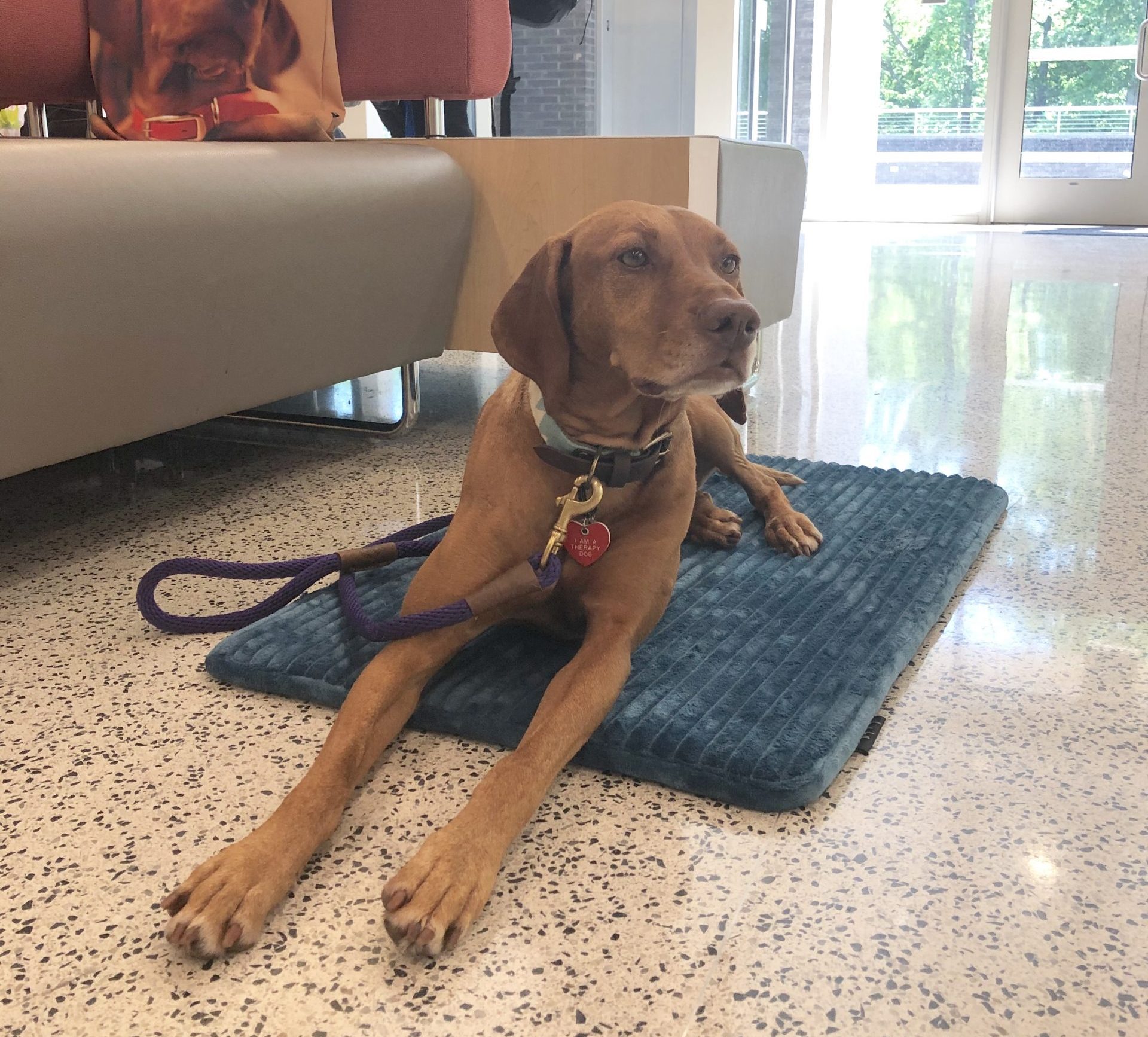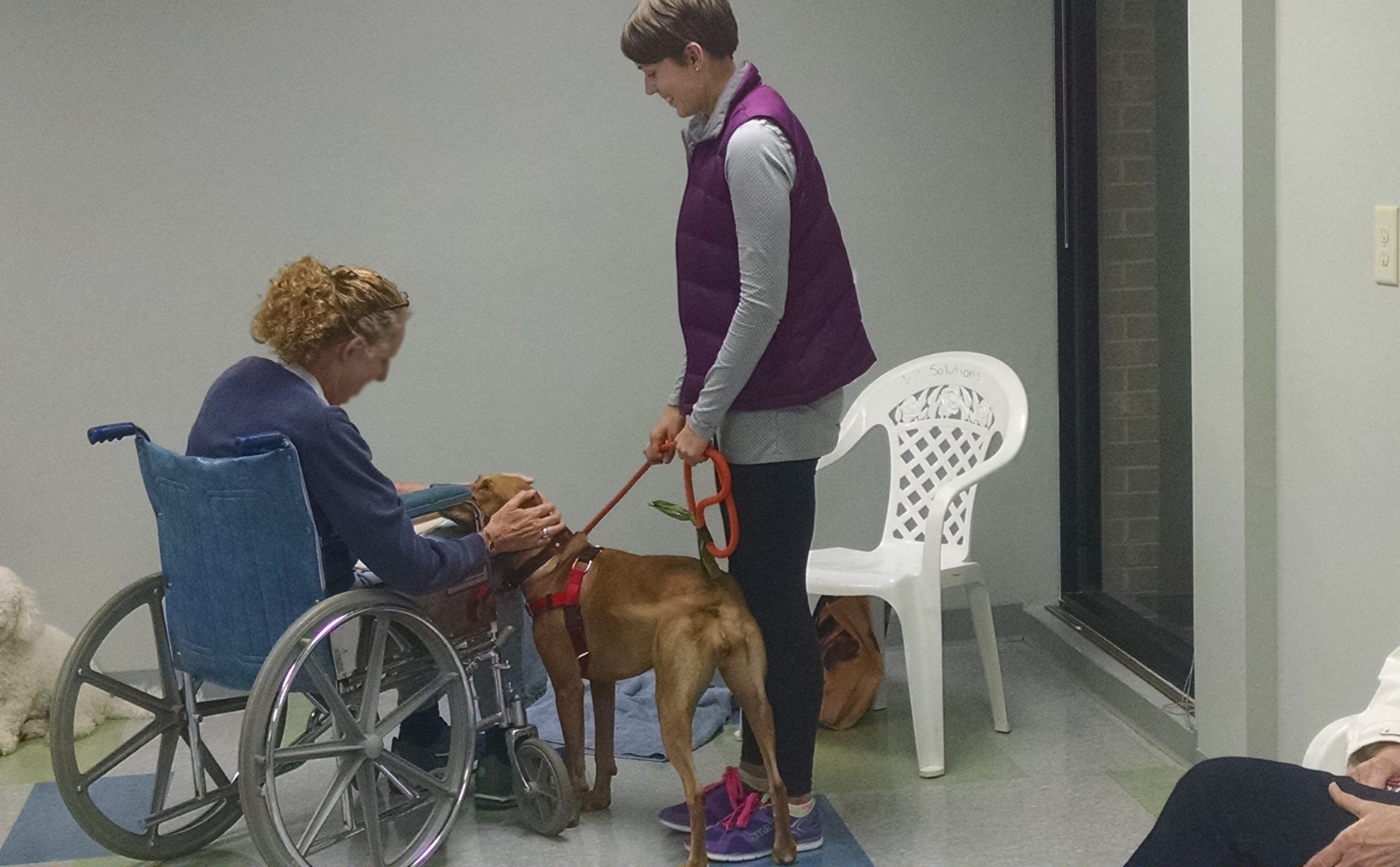This advice can apply to therapy dog training for any dog, not just a high-energy breed. But there are extra things to consider when training and visiting with a highly active dog. Zara and I have been certified as a therapy dog team through The Alliance of Therapy Dogs since 2016. If you are looking to become affiliated with an organization, I highly recommend them.
Temperament and Personality Matter
Some dogs, whether they are high-energy or not, just aren’t cut out to be therapy dogs. They should love people, enjoy attention and being petted, and not be afraid in new situations or reactive. Be honest with yourself about your dog’s personality. Since Zara was a puppy, she has always loved people and lived for attention, so I knew therapy work would be something she would enjoy. On the other hand, I’m not sure if our ridgeback Colombo will ever be up for the task. Even though he has much less energy than Zara and therefore would be easier to manage, he’s not nearly as interested in people and he often shies away from too much attention or rough touch.
If you are getting a puppy and hope to do therapy work, I’d advise talking with your breeder or rescue organization about your plans. They should be able to match you with a dog that is sociable, confident, and recovers easily from setbacks. All of those things can be nurtured as the puppy grows, but it’s helpful to start with a good foundation if you have the option.

Zara on her first therapy visit after being certified. She wears a red heart tag that says “I am a therapy dog.”
Wait Until They Are Mature
This is especially important for high-energy breeds. Zara was three years old when we got certified. The Alliance of Therapy Dogs (ATD) allows dogs as young as one year old to be certified, but there is no way Zara would have been ready when she was one or two. She matured a lot between two and three. Don’t rush your dog into getting certified until they are ready, which might not be until they’re five or six. A middle-aged dog can be very predictable, which is beneficial in a therapy dog.
Socialize Extensively, Even After Puppyhood
Thorough socialization is key in any therapy dog. A high-energy dog can easily get distracted or excited by new stimuli, so it’s important to expose them to a variety of situations before they become a therapy dog. When Zara was younger, I made a habit of taking her everywhere we could (Dog-friendly outdoor store with escalator? Check. Bustling farmer’s market? Check. Hiking trail with narrow bridges to cross? Check.). Even now that both dogs are older, I still look for opportunities to expose them to new things.
Attend a Pet Therapy Class
A lot of therapy dog organizations, including ATD, do not require you to take a pet therapy class. I opted to do this with Zara for additional socialization. Although it might seem unnecessary, I doubt you will regret it. In the class, we focused a lot of time on loose-leash walking and obedience commands like sit, down, and not jumping up. This may seem basic, but a therapy dog needs to be under the owner’s complete control while on a visit. They can’t be yanking their owner down a hallway or jumping up on people.
The instructors had us practice “rough petting” of the dogs since patients or kids who you’re visiting may not always pet the dog in a gentle way or they may be somewhat uncoordinated or have jerky movements. We also practiced hugging the dogs. Thankfully, Zara does not mind hugs. She sometimes hugs us!
We also spent a lot of time working around mobility aids, such as wheelchairs, walkers, and crutches. Zara surprised me by being fine with the wheelchair and walker but being afraid of the crutches. The instructor laid them down on the floor and I praised and gave her treats for sniffing them. It wasn’t long before her negative reaction diminished.
Exercise Immediately Before a Therapy Visit
When Zara and I first starting doing therapy visits, I was very careful to thoroughly exercise her directly beforehand. I would take her to the dog park, engage her in a vigorous game of fetch, and then go directly to the facility (after some clean-up, of course). Now that she’s a little older, I’m less strict about it, but in general, a high-energy dog that gets regular exercise is going to be much more stable and able to tolerate the calmer environment of a nursing home or school than one that does not. I highly doubt that an under-exercised vizsla or border collie will be successful as a therapy dog.
It’s possible that the mental stimulation of visiting with people will tire your dog out after the visit. Or it may not. I remember the instructor of our pet therapy class telling us that after a therapy dog visit, her middle-aged Labrador retriever would be exhausted for a full day afterward. I can tell you that Zara has never been anywhere near exhausted after a visit! But that’s not why we do it.

Train Your Dog to a Mat
Place training, or teaching your dog to stay on a mat or bed, is very useful for therapy work. Whenever we visit a facility where we’ll be positioned in one spot the whole time (instead of walking around visiting people), I always bring a mat with me. As soon as I set it down, I encourage Zara to lay on it with a “settle down” command. I don’t require her to stay on the mat, but it helps to focus her. It’s also a familiar item and reminds her of what she’s supposed to be doing. And if you have a dog like a vizsla, with little body fat or hair to provide cushioning, it will help them be comfortable on a cold, hard floor.
Choose the Right Facility
There are many options for volunteering with your therapy dog. In addition to nursing homes and hospitals, therapy dogs can visit schools, libraries, juvenile detention centers or prisons, college campuses, women’s shelters, and offices. Some of these, like nursing homes or hospices, are ideal for calm pets who might get overwhelmed by too much attention or noise or too many people surrounding them. When we first started volunteering, Zara and I regularly went to a local nursing home. Although she did fine there, I found that she often seemed distracted and not as interested in the older residents with limited mobility. Her favorite place to visit at that place was the physical therapy room, which was staffed by three or four middle-aged women who cried in delight every time they saw her and enthusiastically petted and massaged her.
After that experience, I realized that Zara prefers a higher energy location, like a college campus. We visit Wake Technical Community College during finals week in the fall and spring. The students are easily excited, very animated, and there are often large groups surrounding us, trying to take photos of Zara. She can be more animated with them and I can tell she loves it.
Know Your Dog’s Limits
Especially when you first start out, don’t be afraid to limit the amount of time you spend at a facility. It’s better to have a good 30 minute visit then a one hour visit that turns into a train wreck because your dog is losing their focus. Even after 3+ years of therapy work, I still limit our visits to an hour for the most part. Anything longer than that and Zara tends to get antsy.
Could Your Dog Be a Therapy Dog?
Although vizslas are not typically thought of as good therapy dogs, I personally know several others who are certified. Don’t discount your dog as a potential therapy dog just because they’re higher energy or not one of the “typical” breeds you see a lot (namely, golden retrievers, labs, and small dogs).
Have you considered training your dog to do therapy work? Leave a comment below. And don’t forget to subscribe to my blog so you get an email whenever I write a new post.







Incredible points. Solid arguments. Keep up the good effort.